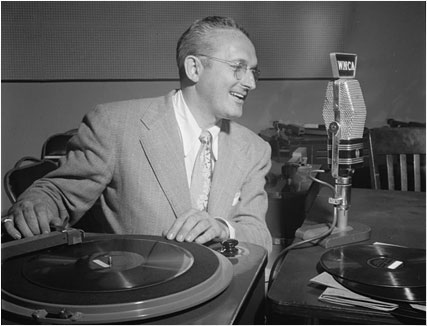|
Index
| Trombone Ensembles
| CD's
| Manufacturers
| Jazz Styles
| Jazz Clubs
| Jazz
Festivals
| Trombone News
| Comments
| Contact
|
|||
|
|
|||
| TOMMY
DORSEY 1905 - 1956
Though he might have been ranked second at any given moment to Benny Goodman, Artie Shaw, Glenn Miller, or Harry James, Tommy Dorsey was overall the most popular bandleader of the swing era that lasted from 1935 to 1945. His remarkably melodic trombone playing was the signature sound of his orchestra, but he successfully straddled the hot and sweet styles of swing with a mix of ballads and novelty songs. He provided showcases to vocalists like Frank Sinatra, Dick Haymes, and Jo Stafford, and he employed inventive arrangers such as Sy Oliver and Bill Finegan. He was the biggest-selling artist in the history of RCA Victor Records, one of the major labels, until the arrival of Elvis Presley, who was first given national exposure on the 1950s television show he hosted with his brother Jimmy. Dorsey was 21 months younger than Jimmy and thus the second son of Thomas Francis Dorsey, Sr., a music teacher and band director, and Theresa Langton Dorsey. Both brothers received musical instruction from their father. Tommy focused on the trombone, though he also played trumpet, especially early in his career. The brothers played in local groups, then formed their own band, Dorsey's Novelty Six, in 1920. By 1922, when they played an engagement at a Baltimore amusement park and made their radio debut, they were calling the group Dorsey's Wild Canaries. During the early and mid-'20s, they played in a series of bands including the Scranton Sirens, the California Ramblers, and orchestras led by Jean Goldkette and Paul Whiteman, sometimes apart, but usually together. Eventually, they settled in New York and worked as session musicians. In 1927, they began recording as the Dorsey Brothers Orchestra for OKeh Records, using pickup bands, and they first reached the charts with "Coquette" in June 1928. In the spring of 1929, they scored a Top Ten hit with "Let's Do It (Let's Fall in Love)," which featured Bing Crosby on vocals. The Dorseys finally organized a full-time band and signed to Decca Records in 1934. Hiring Bing Crosby's younger brother Bob Crosby as their vocalist, they scored a Top Ten hit with "I Believe in Miracles" in the late winter of 1935, quickly followed by "Tiny Little Fingerprints" (vocal by Kay Weber) and "Night Wind" (vocal by Bob Crosby). They then enjoyed successive number one hits with "Lullaby of Broadway" (vocal by Bob Crosby) and "Chasing Shadows" (vocal by Bob Eberly, Bob Crosby's replacement). The Dorsey Brothers Orchestra was poised to become the biggest band in the country in the spring of 1935 and might have been remembered for launching the swing era, but at the end of May the brothers, whose relationship was always volatile, disagreed, and Tommy left the band (which nevertheless scored another Top Ten hit with "Every Little Movement" that summer). Jimmy
Dorsey continued to lead the band, which eventually was billed as
Jimmy Dorsey and His Orchestra and went on to considerable success.
But while the Dorseys stumbled, Benny Goodman achieved national
success and was dubbed "the King of Swing." Tommy Dorsey
took over the remnants of the Joe Haymes band in founding his own
orchestra in the fall of 1935. Signing to RCA Victor Records, he
scored an immediate success with "On Treasure Island"
(vocal by Edythe Wright), which topped the charts in December 1935,
one of four Dorsey records to peak in the Top Ten before the end
of the year. Dorsey was back at number one in January 1936 with
"The Music Goes Round and Round" (vocal by Edythe Wright)
and topped the charts again in February with "Alone" (vocal
by Cliff Weston). "You" (vocal by Edythe Wright) gave
him his third number one in 1936, to which can be added eight other
Top Ten hits during the year. Dorsey was even more successful in
1937, a year in which he scored 18 Top Ten hits, among them the
chart-toppers "Marie" (vocal by Jack Leonard), "Satan
Takes a Holiday" (an instrumental), "The Big Apple,"
"Once in a While," and "The Dipsy Doodle" (vocal
by Edythe Wright). Dorsey earned his own radio series, which ran
for nearly three years. His 15 Top Ten hits in 1938 included the
number one "Music, Maestro, Please" (vocal by Edythe Wright),
and he had another 11 Top Ten hits in 1939, among them "Our
Love" (vocal by Jack Leonard), which hit number one. Notwithstanding
his commercial success, Dorsey made important changes in his band
in late 1939, particularly in his vocalists. Jack Leonard left the
band in November, and Dorsey hired Frank Sinatra away from Harry
James. Longtime female singer Edythe Wright also departed, replaced
by Connie Haines, and the vocal quartet the Pied Pipers, featuring
Jo Stafford, also joined Dorsey. The success only continued with
the new members. DISCOGRAPHY His final film appearance came in Disc Jockey in September 1951. Dorsey switched to Decca Records and continued to perform with his band in the early '50s. In May 1953, Jimmy Dorsey broke up his band and joined his brother's orchestra as a featured attraction; before long, the band was again being billed as the Dorsey Brothers Orchestra. While playing a residency at the Statler Hilton Hotel in New York, the brothers launched a television series, Stage Show, as a summer replacement program in the summer of 1954. It returned on an occasional basis during the 1954-1955 season and ran regularly once a week during the 1955-1956 season. Elvis Presley appeared on the show for six consecutive weeks starting in January 1956, his first nationally broadcast appearances. Sedated by sleeping pills following a heavy meal, Dorsey accidentally choked to death at the age of 51. His brother led his band briefly afterward, but Jimmy Dorsey died in 1957. Nevertheless, the Tommy Dorsey Orchestra continued to record and perform, and under the direction of Warren Covington it scored a final million-selling Top Ten hit in November 1958 with "Tea for Two Cha Cha." Billed as "the sentimental gentleman of swing," Tommy Dorsey successfully combined the hot and sweet aspects of swing music while leading a band that consistently ranked among the top two or three orchestras in the U.S. from the mid-'30s to the mid-'40s, the entire swing era. His band was peopled with major jazz instrumentalists (including Bunny Berigan, Ziggy Elman, Pee Wee Erwin, Max Kaminsky, Buddy Rich, Charlie Shavers, and Dave Tough), arrangers (including Sy Oliver and Paul Weston), and singers (including Frank Sinatra and Jo Stafford) who went on to define popular music in the late '40s and early '50s. He was also an accomplished trombone player whose distinctive sound dominated his band and recordings. The bulk of those recordings were made for RCA Victor, though some later work was done for Decca and Columbia, and of course there are numerous airchecks, making for a large discography.
|


